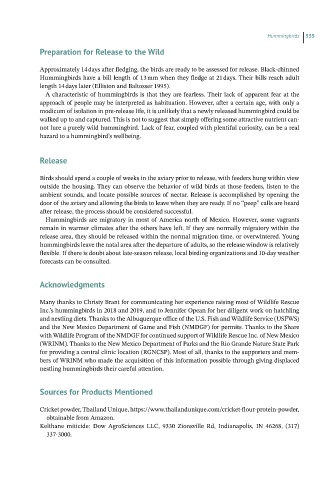Page 537 - Hand rearing birds second
P. 537
Hummingbirds 535
Preparationfor Releaseto the Wild
Approximately 14 days after fledging, the birds are ready to be assessed for release. Black‐chinned
Hummingbirds have a bill length of 13 mm when they fledge at 21 days. Their bills reach adult
length 14 days later (Elliston and Baltosser 1995).
A characteristic of hummingbirds is that they are fearless. Their lack of apparent fear at the
approach of people may be interpreted as habituation. However, after a certain age, with only a
modicum of isolation in pre‐release life, it is unlikely that a newly released hummingbird could be
walked up to and captured. This is not to suggest that simply offering some attractive nutrient can-
not lure a purely wild hummingbird. Lack of fear, coupled with plentiful curiosity, can be a real
hazard to a hummingbird’s wellbeing.
Release
Birds should spend a couple of weeks in the aviary prior to release, with feeders hung within view
outside the housing. They can observe the behavior of wild birds at those feeders, listen to the
ambient sounds, and locate possible sources of nectar. Release is accomplished by opening the
door of the aviary and allowing the birds to leave when they are ready. If no “peep” calls are heard
after release, the process should be considered successful.
Hummingbirds are migratory in most of America north of Mexico. However, some vagrants
remain in warmer climates after the others have left. If they are normally migratory within the
release area, they should be released within the normal migration time, or overwintered. Young
hummingbirds leave the natal area after the departure of adults, so the release window is relatively
flexible. If there is doubt about late‐season release, local birding organizations and 10‐day weather
forecasts can be consulted.
Acknowledgments
Many thanks to Christy Brant for communicating her experience raising most of Wildlife Rescue
Inc.’s hummingbirds in 2018 and 2019, and to Jennifer Opean for her diligent work on hatchling
and nestling diets. Thanks to the Albuquerque office of the U.S. Fish and Wildlife Service (USFWS)
and the New Mexico Department of Game and Fish (NMDGF) for permits. Thanks to the Share
with Wildlife Program of the NMDGF for continued support of Wildlife Rescue Inc. of New Mexico
(WRINM). Thanks to the New Mexico Department of Parks and the Rio Grande Nature State Park
for providing a central clinic location (RGNCSP). Most of all, thanks to the supporters and mem-
bers of WRINM who made the acquisition of this information possible through giving displaced
nestling hummingbirds their careful attention.
Sourcesfor ProductsMentioned
Cricket powder, Thailand Unique, https://www.thailandunique.com/cricket‐flour‐protein‐powder,
obtainable from Amazon.
Kelthane miticide: Dow AgroSciences LLC, 9330 Zionsville Rd, Indianapolis, IN 46268, (317)
337‐3000.

